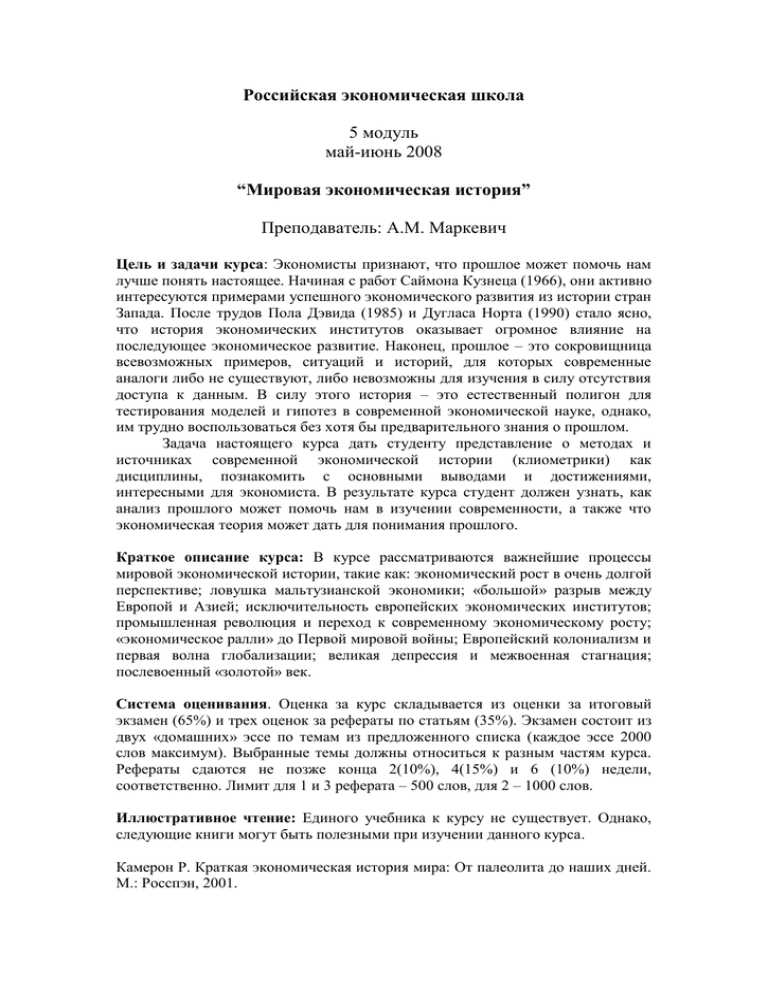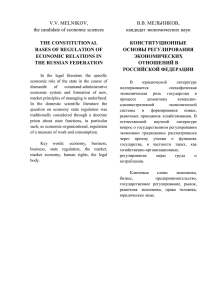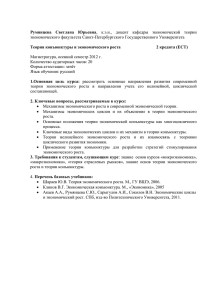Мировая экономическая история - Российская экономическая
advertisement

Российская экономическая школа 5 модуль май-июнь 2008 “Мировая экономическая история” Преподаватель: А.М. Маркевич Цель и задачи курса: Экономисты признают, что прошлое может помочь нам лучше понять настоящее. Начиная с работ Саймона Кузнеца (1966), они активно интересуются примерами успешного экономического развития из истории стран Запада. После трудов Пола Дэвида (1985) и Дугласа Норта (1990) стало ясно, что история экономических институтов оказывает огромное влияние на последующее экономическое развитие. Наконец, прошлое – это сокровищница всевозможных примеров, ситуаций и историй, для которых современные аналоги либо не существуют, либо невозможны для изучения в силу отсутствия доступа к данным. В силу этого история – это естественный полигон для тестирования моделей и гипотез в современной экономической науке, однако, им трудно воспользоваться без хотя бы предварительного знания о прошлом. Задача настоящего курса дать студенту представление о методах и источниках современной экономической истории (клиометрики) как дисциплины, познакомить с основными выводами и достижениями, интересными для экономиста. В результате курса студент должен узнать, как анализ прошлого может помочь нам в изучении современности, а также что экономическая теория может дать для понимания прошлого. Краткое описание курса: В курсе рассматриваются важнейшие процессы мировой экономической истории, такие как: экономический рост в очень долгой перспективе; ловушка мальтузианской экономики; «большой» разрыв между Европой и Азией; исключительность европейских экономических институтов; промышленная революция и переход к современному экономическому росту; «экономическое ралли» до Первой мировой войны; Европейский колониализм и первая волна глобализации; великая депрессия и межвоенная стагнация; послевоенный «золотой» век. Система оценивания. Оценка за курс складывается из оценки за итоговый экзамен (65%) и трех оценок за рефераты по статьям (35%). Экзамен состоит из двух «домашних» эссе по темам из предложенного списка (каждое эссе 2000 слов максимум). Выбранные темы должны относиться к разным частям курса. Рефераты сдаются не позже конца 2(10%), 4(15%) и 6 (10%) недели, соответственно. Лимит для 1 и 3 реферата – 500 слов, для 2 – 1000 слов. Иллюстративное чтение: Единого учебника к курсу не существует. Однако, следующие книги могут быть полезными при изучении данного курса. Камерон Р. Краткая экономическая история мира: От палеолита до наших дней. М.: Росспэн, 2001. Ван дер Вее Г. История мировой экономики, 1945-1990; Пер. с фр. А.И.Тихонова; Под. ред. В.И.Бовыкина. — М.: Наука, 1994. Kenwood, A.G. and Lougheed, A.L. (1999), The Growth of the International Economy, 1820-1990: An Introductory Text, (4th edition), London: Routledge. Maddison, A. (2001), The World Economy: A Millennial Perspective, Paris: OECD. Pomeranz, K. and Topik, S. (2006), The World that Trade Created. Society, Culture, and the World Economy, 1400 to the Present (2nd edition). London and New York. Историческая статистика может быть найдена на следующих сайтах: http://www.iisg.nl/hpw/data.php#europe – историческая статистика цен и зарплаты http://www.ggdc.net/maddison/ - статистика ВВП по странам http://www.nber.org/databases/macrohistory/contents/ - экономическая статистика США для периода до Первой мировой войны и межвоенного периода http://www2.history.ubc.ca/unger/htm_files/wheat.htm - статистика цен на зерно Структура курса: Курс состоит из 14 лекций. * - обязательные статьи ** - статьи для рефератов 1. Введение. Что такое экономическая история? Краткая история дисциплины. Что мы можем выучить из прошлого. QWERRTY эффект и зависимость от прошлого. Краткий количественный обзор развития мировой экономики, 1-2001 н.э. Crafts, N.F.R. (1987), “Cliometrics, 1971-1986: A Survey”, Journal of Applied Econometrics, 2, 171-92. Crouzet, F. (2001), A History of the European Economy, 1000-2000, Charlottesville, VA: University Press of Virginia. *David, Paul A. (1985), “Clio and the Economics of QWERTY.” American Economic Review 75 (May): 332-7. Gerschenkron Alexander (1967), “The Discipline and I”, The Journal of Economic History, 27(4): 443-59. Liebowitz, S.J., and Stephen E. Margolis. 1995. "Path Dependence, Lock-In, and History." Journal of Law, Economics, and Organization 11: 204-26. http://wwwpub.utdallas.edu/~liebowit/paths.html Maddison Angus (2005) ‘Measuring and Interpreting World Economic Performance, 1500–2001’, Review of Income and Wealth, 51 (1). Maddison, Angus. (2001). The World Economy: A Millennial Perspective. OECD, Paris. North, D.C. (1990), Institutions, Institutional Change and Economic Development, Cambridge: Cambridge University Press. **North, Douglas C., John Joseph Wallis and Brry R. Weingast (2006) “A Conceptual Framework for Interpreting Recorded Human History”, NBER Working paper 12795. McCloskey Donald (1976), “Does the Past Have Useful Economics?” Journal of Economic Literature, 14(2): 434-61. Phelps Brown, H. and Hopkins, S.V. (1956), “Seven Centuries of the Prices of Consumables compared with Builders’ Wage Rates”, Economica, 23: 296-314. Puffert Douglas ‘Path Dependence’, Mimeo, 1999. (http://eh.net/encyclopedia/article/puffert.path.dependence) . Камерон Р. Краткая экономическая история мира: От палеолита до наших дней. М.: Росспэн, 2001. 2. «Большой разрыв» в жизненных стандартах в Европе и Азии. *Allen, R.C. (2001), “The Great Divergence in European Wages and Prices from the Middle Ages to the First World War”, Explorations in Economic History, 38: 411447. *Broadberry, S.N. and Gupta, B. (2006), “The Early Modern Great Divergence: Wages, Prices and Economic Development in Europe and Asia, 1500-1800”, Economic History Review, 59: 2-31. Broadberry, S.N. and Gupta, B. (2007), “Cotton Textiles and the Great Divergence: Lancashire, India and Shifting Competitive Advantage, 1600-1850”, Working paper. University of Warwick, http://www2.warwick.ac.uk/fac/soc/economics/staff/faculty/broadberry/wp/ Clark, Gregory (1998) ‘Work in Progress? Industrious Revolution’ The Journal of Economic History, 58(3): 830-843. Parthasarathi, P. (1998), “Rethinking Wages and Competitiveness in the Eighteenth Century: Britain and South India”, Past and Present, 158: 79-109. Pomeranz, K. (2000), The Great Divergence: China, Europe, and the Making of the Modern World Economy, Princeton: Princeton University Press. Van Zanden, Jan (1999) “Wages and the standard of living in Europe”, Eropean Review of Economic History, 2: 175-197. Vries Jan De (1994), “The Industrial Revolution and the Industrious Revolution”, The Journal of Economic History, 54(2): 249-270. 3. Межконтинентальная торговля и торговый капитализм. *Acemoglu, D., Johnson, S. and Robinson, R. (2005), “The Rise of Europe: Atlantic trade, Institutional Change and Economic Growth”, American Economic Review, 95(3): 546-79. Allen, R.C. (2003),“Progress and poverty in early modern Europe” Economic History Review, LVI (3): 403–443. O'Brien, Patrick K. (1988), ‘The Costs and Benefits of British Imperialism 18461914’, Past and Present, 120: 163-200. O'Brien, Patrick K. (1982), ‘European Economic Development: The Contribution of the Periphery’, The Economic History Review, 35(1): 1-18. Clark, Gregory. (1987), ‘Productivity Growth without Technical Change in European Agriculture before 1850’, The Journal of Economic History, 47(2): 419-432 Coelho, P.R.P (1973), “The Profitability of Imperialism: The British Experience in the West Indies, 1768-72”, Explorations in Economic History, 10, 253-80. Deng, K.G. (2000), “A Critical Survey of Recent Research in Chinese Economic History”, Economic History Review, 53: 1-28. *Maddison, Angus. (2001). The World Economy: A Millennial Perspective. OECD, Paris. Maddison, Angus. (1998). ‘Chinese Economic Performance in the Long-run’ . OECD, Paris. Thomas, Robert Paul (1968), ‘The Sugar Colonies of the Old Empire: Profit or Loss for Great Britain?’, The Economic History Review, 21(1): 30-45. 4. Институты и Европейская исключительность. Clay, Karen, (1997), ‘Trade without Law: Private-Order Institutions in Mexican California’, Journal of Law, Economics, & Organization, 13 (1): 202-231. Easterly William and Ross Levine, 2003), ‘Tropics, germs, and crops: how endowments influence economic development’, Journal of Monetary Economics, 50: 3–39. Greif, A. (1994), “Cultural Beliefs and the Organisation of Society: A Historical and Theoretical Reflection on Collectivist and Individualist Societies”, The Journal of Political Economy, 102(5): 912-50. *Greif, Avner (2000), “The Fundamental Problem of Exchange: A Research Agenda in Historical Institutional Analysis”, European Review of Economic History, 4: 251284. Greif, Avner, Paul Milgrom & Barry R. Weingast, (1994) ‘Coordination, Commitment, and Enforcement: The Case of the Merchant Guild”. The Journal of Political Economy, 102 (4): 745-76. De Long J. Bradford and Andrei Shleifer ‘Princes and Merchants: European City Growth before the Industrial Revolution’, Journal of Law and Economics, 36(2): 671702. North, Douglass C. (1990), Institutions, Institutional Change, and Economic Performance. Cambridge: Cambridge University Press. North, Douglass C. (2005), Understanding the process of economic change. Princeton and Oxford. North, Douglas C., John Joseph Wallis and Brry R. Weingast (2006) “A Conceptual Framework for Interpreting Recorded Human History”, NBER Working paper 12795. Olson, M. (1993), “Dictatorship, Democracy and Development”, American Political Science Review, 87: 567-576. Persson Karl Gunnar (1993) “Was There a Productivity Gap between FourteenthCentury Italy and England?” The Economic History Review, 46(1): 105-114. Sokoloff Kenneth L. and Stanley L. Engerman, (2000), ‘History Lessons: Institutions, Factors Endowments, and Paths of Development in the New World’, The Journal of Economic Perspectives, 14(3): 217-232. 5. Промышленная революция. Clark, Gregory (forthcoming) The Conquest of Nature. Clark, Gregory. (1987), ‘Productivity Growth witout Techincal Change in European Agriculture before 1850’, The Journal of Economic History, 47(2): 419-432 Clark, Gregory. (1991), ‘Yields per Acre in English Agriculture, 1250-1860: Evidences from Labout Inputs’, The Economic History Review, 44(3): 445-460. Clark, Gregory, Michael Huberman and Peter H. Lindert (1995) ‘A British Food Puzzle, 1770-1850’, The Economic History Review, 48(2): 215-237. Clark, Gregory (1996), “The Political Foundations of Modern Economic Growth: England, 1540-1800,” Journal of Interdisciplinary History, 26:563-88. Clark, Gregory. (1998), “Commons Sense: Property Rights, Efficiency and Institutional Change,” The Journal of Economic History, 58(1):73-102. Clark, G. (2005), “The Condition of the Working-Class in England, 1209-2003”, Journal of Political Economy, 113: 1307-1340. Craft N.F.R. (1978) “Industrial Revolution in England and France: Some Thoughts on the Question, “Why was England First?” Economic History Review, 31(4): 429-41. Crafts, N.F.R. (1985), British Economic Growth During the Industrial Revolution, Oxford: Clarendon. *Crafts N. F. R. and C. K. Harley (1992), “Output Growth and the British Industrial Revolution: A Restatement of the Crafts-Harley View”, The Economic History Review, 45(4): 703-30. **Crafts N.F.R. and C. Knick Harley, (2000) “Simulating the Two Views of the British Industrial Revolution,” and a reply by Temin, The Journal of Economic History, 819-846. Galor, O. and Moav, O. (2002), “Natural Selection and the Origin of economic Growth”, Quarterly Journal of Economics, 117: 1133-1191. *Galor, O. and Weil, D.N. (2000), “Population, Technology, and Growth: From Malthusian Stagnation to Demographic Transition and Beyond”, American Economic Review, 90: 806-828. Kuznets, S. (1974), Population, Capital and Economic Growth: Selected Essays, London: Heinemann. Lee, Ronald D. (2003) “The Demographic Transition: Three Centuries of Fundamental Change”, Journal of Economic Perspectives 17(4): 167-190, Mokyr, J. (2002), The Gifts of Athena: Historical Origins of the Knowledge Economy, Princeton: Princeton University Press. North, D.G. and Weingast, B.R. (1989), “Constitutions and Commitment: The Evolution of Institutions Governing Public Choice in Seventeenth-Century England”, The Journal of Economic History, 49: 803-832. **Temin, Peter (1997),“Two Views of the British Industrial Revolution,” The Journal of Economic History, 57(1): 63-82. **Temin, Peter (2000), ‘A Response to Harley and Craft’, The Journal of Economic History, 60(3): 842-846. Wrigley, E.A., Davies, R.S., Oeppen, J.E. and Schofield, R.S. (1997), English Population History from Family Reconstitution, 1580-1837, Cambridge: Cambridge University Press. 6. Глобализация 19 века. Bordo, M., Eichengreen, B. and Irwin, D. (1999), "Is Globalization Today Really Different than 100 Years Ago ?", NBER Working Paper No. 7195. Bordo, M., Taylor, A. and Williamson, J. G. (2003), Globalization in Historical Perspective. Chicago: University of Chicago Press. Broadberry Stephen N. and Douglas A. Irwin (2006) “Labour and productivity in the United States and the United Kingdom during the nineteenth century”, Explorations in Economic Hisotry, 43: 257-279. Clark, Gregory (1984), ‘Authority and Efficiency: the Labour Market and the Managerial Revolution of the Late Nineteenth Century’, The Journal of Economic History, 44(4), 1069-1083. Clark, Gregory (1987), ‘Why isn’t the Whole World Developed? Lessons from the Cotton Mills’, The Journal of Economic History, 47(1): 141-173. Crafts, N. (2004), "Globalization and Economic Growth: an Historical Perspective", The World Economy, 27, 45-58. Crafts, N. (2005), "The 'Death of Distance': What Does It Mean for Economic Development?", World Economics, 6(3), 1-14. Eloranta Jari (2007), ‘From the great illusion to the Great War: Military spending behaviour of the Great Powers, 1870–1913’, European Review of Economic History, 11: 255–283. Gordon Robert J. ‘Two Centuries of Economic Growth: Europe Chasing the American Frontier’, NBER Working Paper 10662 (http://www.nber.org/papers/w10662). Lamoreaux, Naomi R. (1986), ‘Banks, Kinship, and Economic Development: The New England Case’, The Journal of Economic History, 46(3): 647-667. Kuznets, Simon 1966. Modern Economic Growth: Rate, Structure, and Spread. Yale University Press, New Haven, CT Rothbarth E. (1946), “Causes of the Superior Efficiency of USA. Industry as Compared with British Industry” The Economic Journal, 56(223): 383-390. O'Rourke, K. and Williamson, J. (2002), "When Did Globalization Begin?" European Review of Economic History, 6: 23-50. O’Rourke Kevin and Jeffrey G. Williamson (2002), “After Columbus: Explaining the Global Trade Boom 1500-1800,” The Journal of Economic History 62(2): 417-56. *Williamson, Jeffrey G. ‘Globalization, Convergence, and History’, The Journal of Economic History, 56(2): 277-306. 7. Экономический рост с 1870 г. Abramovitz Moses (1986), “Catching Up, Forging Ahead, and Falling Behind”, The Journal of Economic Hisotry, 46(2): 385-406. *Acemoglu, D. and Johnson, S. (2005), “Unbundling Institutions”, Journal of Political Economy, 113: 949-95. Baumol, W.J. (1986),”Productivity Growth, Convergence and Welfare: What the Long Run Data Show”, American Economic Review, 76: 1072-1085. Crafts Nicholas (2002), ‘The Human Development Index, 1870- 1999: Some revised estimates’ European Review of Economic History, 6: 395-405. De Long, J.B. (1988), “Productivity Growth, Convergence and Welfare: Comment”, American Economic Review, 78, 1138-1154. Dollar David and Aart Kraay ‘Trade, Growth, and Poverty’ The Economic Journal, 114: F22–F49. Findlay, R. and O'Rourke, K. (2003), "Commodity Market Integration 1500-2000" in M. Bordo, A. Taylor and J. Williamson (eds.), Globalization in Historical Perspective. Chicago, University of Chicago Press. Glaeser Edward, Rafael La Porta, Florencio Lopez-de-Silanes and Andrei Schleifer (2004), ‘Do Institutions Cause Growth?’ Journal Of Economic Growth, (9): 271-303. Irwin, D. (2002), "Long-Run Trends in World Trade and Income", World Trade Review, 1: 89-100. *Hall, Robert E. and Charles I. Jones, (1999), ‘Why Do Some Countries Produce So Much More Output Per Worker Than Others?’, The Quarterly Journal of Economics, 114(1): 83-116. Knack Stephen and Philip Keefer, (1997) ‘Does Social Capital Have an Economic Payoff? A Cross-Country Investigation’ The Quarterly Journal of Economics, 112(4):1251-1288. Levine Ross and David Renelt ‘A Sensitivity Analysis of Cross-Country Growth Regressions’ The American Economic Review, 82(4): 942-963. 8. Золотой стандарт и межвоенный финансовый режим. Eichengreen, B. and Sachs, J. (1985), "Exchange Rates and Economic Recovery in the 1930s", The Journal of Economic History, 45: 925-46. * Eichengreen, B. (1993), Globalising Capital: A History of the International Monetary System. Princeton University Press. Feinstein Charles H. and Peter Temin (1994), ‘The European Economy between Wars’, Oxford University Press. McKinnon, Ronald I. (1993), “The Rules of the Game: International Money in Historic Perspective,” Journal of Economic Literature, 31: 1-44. Milton Friedman and Anna Schwartz (1963), A Monetary History of the United States, 1867-1960 Princeton University Press. 9. Великая Депрессия. Bernanke, B. (1995), "The Macroeconomics of the Great Depression: a Comparative Approach", Journal of Money, Credit and Banking, 27: 1-28. *Eichengreen, B. (2004), "Understanding the Great Depression", Canadian Journal of Economics, 37(1): 1-27. Eichengreen, B. and Portes, R. (1986), "Debt and Default in the 1930s: Causes and Consequences", European Economic Review, 30: 599-640. Feinstein, C. H., Temin, P. and Toniolo, G. (1997), The European Economy Between the Wars. Oxford: Oxford University Press. Grossman, R. S. (1994), "The Shoe that Didn't Drop: Explaining Banking Stability during the Great Depression", The Journal of Economic History, 54: 654-82. Higgs, Robert (1997), ‘Depression, 1929, the US’, Independent Review, 1(4): 561-591. Milton Friedman and Anna Schwartz (1963), A Monetary History of the United States, 1867-1960 Princeton University Press. Romer, C. (1992), "What Ended the Great Depression ?" The Journal of Economic History, 52: 757-84. 10. Послевоенный «золотой» век. Ван дер Вее Г. История мировой экономики, 1945-1990; Пер. с фр. А.И.Тихонова; Под. ред. В.И.Бовыкина. — М.: Наука, 1994. Broadberry, S. N. (1998), "How Did the United States and Germany Overtake Britain ? A Sectoral Analysis of Comparative Productivity Levels", The Journal of Economic History, 58(2): 375-407. Broadberry, S. N. and Crafts, M. (2003), "UK Productivity Performance from 1950 to 1979: a Restatement of the Broadberry-Crafts View", Economic History Review, 56, 718-735. Cameron, G. and Wallace, C. (2002), “Macroeconomic Performance in the Bretton Woods Era and After”, Oxford Review of Economic Policy, 18(4): 479-494. Crafts, N. (2004), "Fifty Years of Economic Growth in Western Europe: No Longer Catching Up but Falling Behind ?", World Economics, 5(2): 131-145. Crafts, N. and Mills, T. C. (2005), "TFP Growth in British and German Manufacturing, 1950-1996", Economic Journal, 115: 649-670. *Crafts Nicholas (2004), ‘Fifty Years of Economic Growth in Western Europe. No longer catching up but falling behind?’ World Economics , 5(2). Clark Gregory (1986), ‘British Labour in Britain’s Decline’, The Journal of Economic History, 46(2): 498-500. Gordon Robert J. ‘Two Centuries of Economic Growth: Europe Chasing the American Frontier’, NBER Working Paper 10662 (http://www.nber.org/papers/w10662). **Nelson, R. R. and Wright, G. (1992), "The Rise and Fall of American Technological Literature, 30(4): 1931-1964 Nicoletti, G. and Scarpetta, S. (2003), "Regulation, Productivity and Growth: OECD Evidence", Economic Policy, 36: 11-72. *Temin, P. (2002), "The Golden Age of European Growth Reconsidered", European Review of Economic History, 6(1): 3-22. van Ark, B. and Inklaar, R. (2006), "Catching Up or Getting Stuck ? Europe's Troubles to Exploit ICT's Productivity Potential", Groningen Growth & Development Centre Research Memorandum GD 79.

